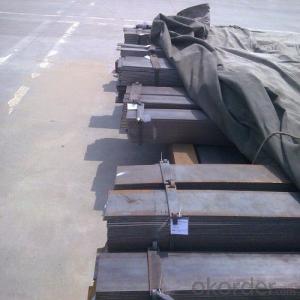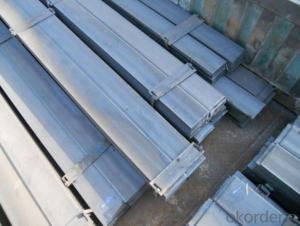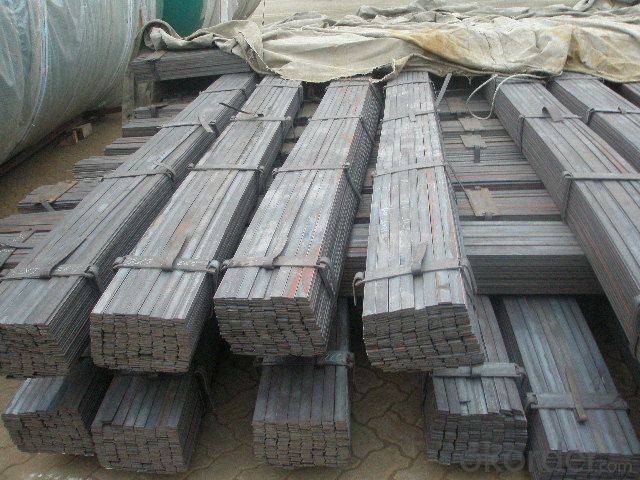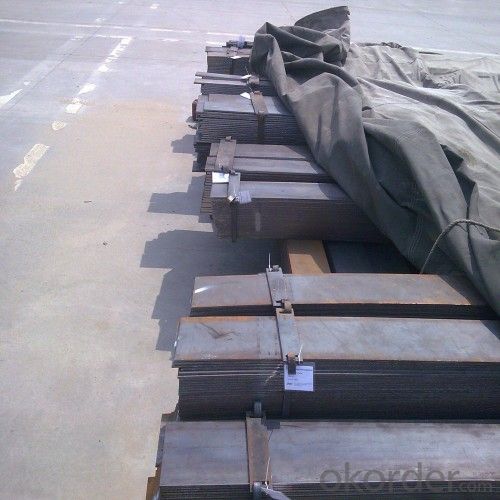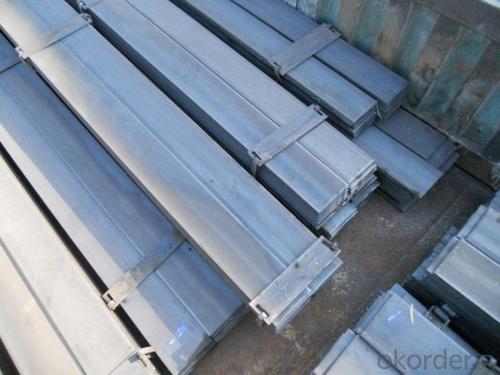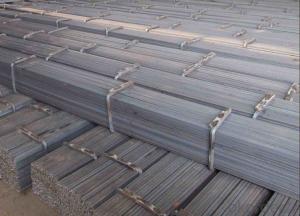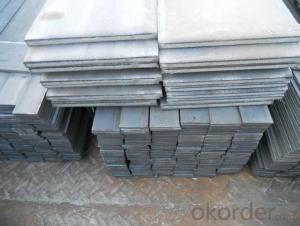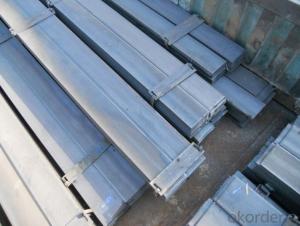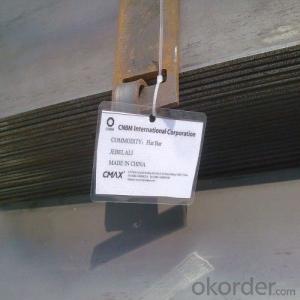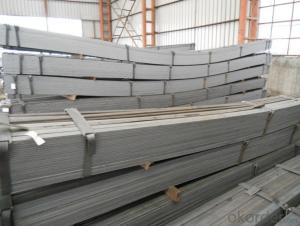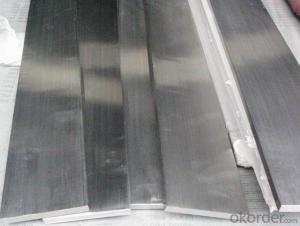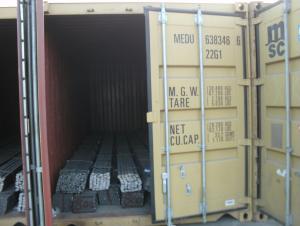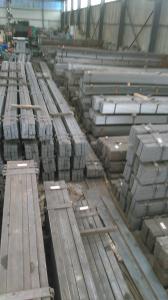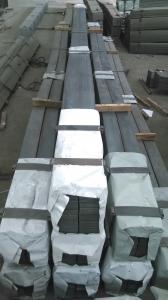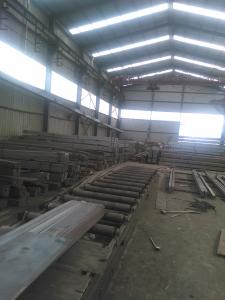Hot Rolled Steel Flat Bar in Material Grade Q235
- Loading Port:
- Tianjin
- Payment Terms:
- TT OR LC
- Min Order Qty:
- 25 m.t.
- Supply Capability:
- 10000 m.t./month
OKorder Service Pledge
OKorder Financial Service
You Might Also Like
Product Description:
OKorder is offering high quality Hot Rolled Steel Flat bars at great prices with worldwide shipping. Our supplier is a world-class manufacturer of steel, with our products utilized the world over. OKorder annually supplies products to European, North American and Asian markets. We provide quotations within 24 hours of receiving an inquiry and guarantee competitive prices.
Product Applications:
Hot Rolled Steel Flat bars are ideal for structural applications and are widely used in the construction of buildings and bridges, and the manufacturing, petrochemical, and transportation industries.
Product Advantages:
OKorder's Steel Flat bars are durable, strong, and resist corrosion.
Main Product Features:
· Premium quality
· Prompt delivery & seaworthy packing (30 days after receiving deposit)
· Corrosion resistance
· Can be recycled and reused
· Mill test certification
· Professional Service
· Competitive pricing
Product Specifications:
Manufacture: Hot rolled
Grade: Q195 – 235
Certificates: ISO, SGS, BV, CIQ
Length: 6m – 12m, as per customer request
Packaging: Export packing, nude packing, bundled
Chemical composition of Q235
Alloy No | Grade | Element(%) | ||||
C | Mn | S | P | Si | ||
Q235 | B | 0.12—0.20 | 0.3—0.7 | ≤0.045 | ≤0.045 | ≤0.3 |
Physical properties of Q235
Alloy No | Grade | Yielding strength point(Mpa) | Tensile strength (Mpa) | Elongation after fracture(%) | ||||||
Thickness (mm) | Thickness (mm) | |||||||||
≤16 | >16--40 | >40--60 | >60--100 | ≤16 | >16--40 | >40--60 | >60--100 | |||
≥ | ≥ | |||||||||
Q235 | B | 235 | 225 | 215 | 205 | 375--500 | 26 | 25 | 24 | 23 |
FAQ:
Q1: Why buy Materials & Equipment from OKorder.com?
A1: All products offered byOKorder.com are carefully selected from China's most reliable manufacturing enterprises. Through its ISO certifications, OKorder.com adheres to the highest standards and a commitment to supply chain safety and customer satisfaction.
Q2: How do we guarantee the quality of our products?
A2: We have established an advanced quality management system which conducts strict quality tests at every step, from raw materials to the final product. At the same time, we provide extensive follow-up service assurances as required.
Q3: How soon can we receive the product after purchase?
A3: Within three days of placing an order, we will begin production. The specific shipping date is dependent upon international and government factors, but is typically 7 to 10 workdays.
Images:
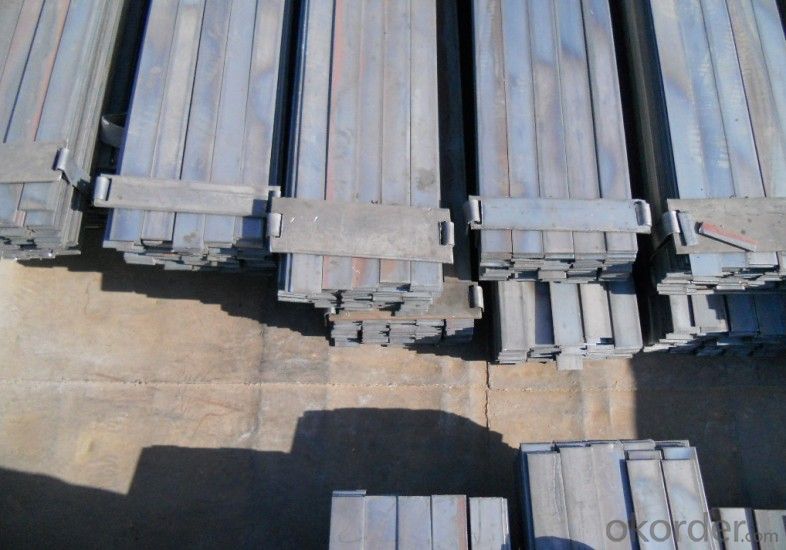
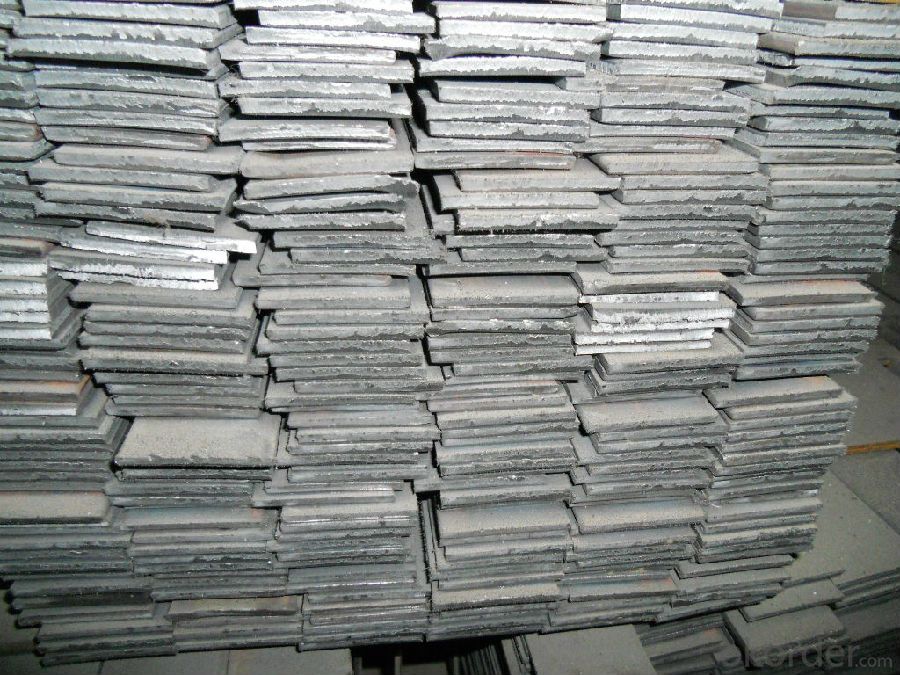
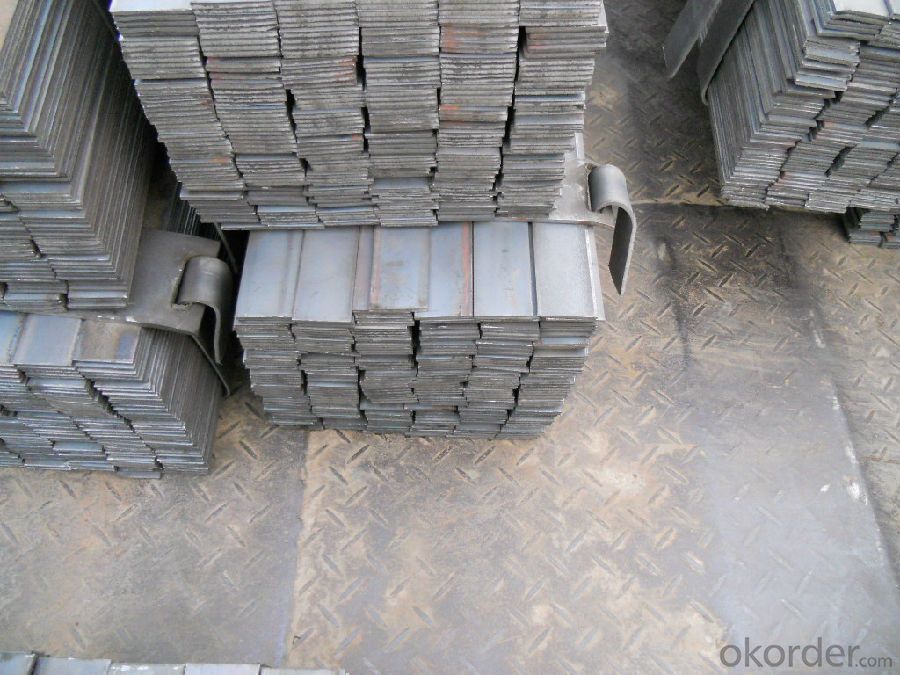
- Q: Are steel flat bars suitable for electrical grounding?
- Steel flat bars are indeed suitable for electrical grounding due to their ability to conduct electricity effectively. The conductivity of steel is a crucial characteristic for grounding materials. By being installed and connected correctly to the electrical system, steel flat bars can efficiently disperse electrical charges and create a secure route for electrical faults to be redirected to the ground. Nevertheless, it is vital to guarantee that the steel bars are firmly bonded and connected to the grounding system in compliance with the relevant electrical codes and standards. Furthermore, regular maintenance and inspections are necessary to uphold the integrity and effectiveness of the grounding system.
- Q: How strong are steel flat bars?
- Strength and durability are characteristics commonly associated with steel flat bars. The grade and composition of the steel used can affect the strength of these flat bars. Mild steel, which contains a low amount of carbon, is often used to create steel flat bars due to its ductility and ease of manipulation. Mild steel flat bars possess moderate strength and find application in various fields, including construction, manufacturing, and fabrication. Conversely, high-strength steel flat bars, crafted from alloys or subjected to heat treatment, exhibit significantly enhanced strength properties. These specialized flat bars are designed to endure substantial loads, resist deformation, and offer structural support in demanding scenarios. Their usage is prevalent in industries such as construction, automotive, and aerospace. In general, steel flat bars are acknowledged for their strength and capacity to withstand substantial force and weight. Nonetheless, selecting the appropriate grade and size of steel flat bar for a particular application is crucial to ensure optimal strength and performance. Consulting with a structural engineer or steel supplier can aid in determining the most suitable type of steel flat bar for a specific project.
- Q: How do you protect steel flat bars from UV radiation or sun damage?
- To protect steel flat bars from UV radiation or sun damage, there are several measures that can be taken. Firstly, applying a protective coating on the surface of the steel bars can help shield them from the harmful effects of UV rays. One common option for this is to use a high-quality paint that is specifically formulated for outdoor use. This paint should have UV-resistant properties to prevent fading or discoloration of the steel bars. Another effective method is to use a clear sealant or varnish that contains UV inhibitors. These products create a protective barrier on the surface of the steel, preventing the penetration of UV radiation and minimizing the risk of sun damage. It is advisable to choose a sealant that is designed for use on metal surfaces to ensure maximum effectiveness. In addition to the above measures, it is important to regularly clean and maintain the steel flat bars. This includes removing any dirt, dust, or other debris that may accumulate on the surface, as these can act as magnifiers for UV radiation, intensifying the damage. Regular inspections should also be conducted to identify any signs of corrosion or deterioration, as these can weaken the steel and make it more susceptible to UV damage. Lastly, if the steel flat bars are exposed to direct sunlight for extended periods, it is recommended to provide some form of shade or cover to reduce the intensity of UV exposure. This can be achieved by using awnings, canopies, or other types of protective structures that block or diffuse the sunlight. By implementing these protective measures, the steel flat bars can be safeguarded against UV radiation and sun damage, ensuring their longevity and maintaining their structural integrity.
- Q: The minus sign in front of what 40 galvanized flat steel
- Refers to the galvanized flat steel, width 12-300mm, thickness 4-60mm, cross section is rectangular and with pure edge of galvanized steel. Galvanized flat steel can be finished steel, also can be galvanized pipe blank and galvanized belt.
- Q: How do steel flat bars differ from steel round bars?
- Steel flat bars and steel round bars differ in their shape and structural properties. The most obvious difference between steel flat bars and steel round bars is their shape. Steel flat bars are characterized by their rectangular shape with sharp edges and a flat surface on the top and bottom. On the other hand, steel round bars have a circular cross-section, resembling a rod or a cylinder. In terms of structural properties, steel flat bars and steel round bars also vary. Steel flat bars are often preferred for applications that require a high load-bearing capacity in a horizontal direction, such as supporting weight or providing structural stability. Their flat surface allows for better distribution of weight and helps prevent bending or warping under heavy loads. Steel round bars, on the other hand, are commonly used in applications that require strength and durability in various directions, including vertical and horizontal forces. The circular shape of round bars provides excellent resistance to bending and twisting, making them suitable for applications such as construction, machinery, and automotive components. Additionally, the manufacturing process for steel flat bars and steel round bars may also differ. Steel flat bars are typically produced by hot rolling, which involves passing heated steel through a series of rollers to achieve the desired shape. Steel round bars can be produced by both hot rolling and cold drawing processes, where the steel is either heated and passed through rollers or pulled through a die to form the circular shape. In summary, steel flat bars and steel round bars differ in terms of shape, structural properties, and manufacturing processes. Understanding these differences is crucial when selecting the appropriate steel bar for a specific application.
- Q: Can steel flat bars be used for manufacturing machine guards?
- Yes, steel flat bars can be used for manufacturing machine guards. Steel is a strong and durable material, making it suitable for protecting machines and providing safety barriers. Steel flat bars can be easily cut and shaped to fit the specific requirements of the machine guard, allowing for custom designs and sizes. Additionally, steel flat bars can withstand impact and provide a sturdy barrier against potential hazards in industrial environments. Overall, steel flat bars are a commonly used material for manufacturing machine guards due to their strength, versatility, and ability to provide adequate protection.
- Q: Are steel flat bars suitable for electrical conductivity applications?
- No, steel flat bars are not suitable for electrical conductivity applications. Steel is a poor conductor of electricity compared to other materials like copper or aluminum. While steel can conduct electricity to some extent, its conductivity is significantly lower than that of metals specifically designed for electrical applications. Therefore, it is recommended to use materials with higher electrical conductivity, such as copper or aluminum, for electrical conductivity applications.
- Q: How do steel flat bars perform in terms of strength and durability?
- The exceptional strength and durability of steel flat bars are well-known. Steel, with its unique properties, gives flat bars high tensile strength, enabling them to withstand large amounts of force without bending or breaking. This quality makes them perfect for applications that necessitate structural support or load-bearing capabilities. In addition, steel flat bars also possess outstanding durability. They have a high resistance to corrosion, which is a primary factor that weakens and damages metals over time. This corrosion resistance makes steel flat bars suitable for both indoor and outdoor use, even in harsh environments. Moreover, steel flat bars can endure extreme temperatures without compromising their strength. They are highly resistant to heat, making them suitable for applications involving high temperatures, such as construction, manufacturing, and machinery. Furthermore, steel flat bars are versatile and can be easily fabricated and machined into various shapes and sizes, making them suitable for a wide range of applications. They can be welded, bent, drilled, and cut, allowing for customization and adaptability to meet specific project requirements. In conclusion, steel flat bars are renowned for their exceptional strength and durability, making them a popular choice in diverse industries, including construction, automotive, manufacturing, and infrastructure. Their ability to withstand heavy loads, resist corrosion, and adapt to different conditions make them a reliable and long-lasting option for numerous applications.
- Q: How do steel flat bars compare to fiberglass flat bars?
- Distinct differences exist between steel flat bars and fiberglass flat bars in terms of composition, properties, and applications. To begin with, steel flat bars are manufactured by heating a solid steel billet and passing it through rollers to achieve the desired shape. Renowned for their exceptional strength, durability, and resistance to bending and impact, steel flat bars are able to withstand heavy loads. Consequently, they are commonly utilized in the construction, manufacturing, and machinery industries. Moreover, steel flat bars exhibit high resistance to fire and extreme temperatures. On the other hand, fiberglass flat bars are composed of glass fibers embedded in a resin matrix. This unique composition grants them properties such as being lightweight, corrosion-resistant, and non-conductive. Consequently, fiberglass flat bars find common usage in industries where electrical conductivity or non-magnetic properties are indispensable, such as electrical and telecommunications applications. Additionally, their resistance to water, chemicals, and UV radiation makes them suitable for employment in marine and automotive industries. When comparing strength, steel flat bars generally possess a higher tensile strength than fiberglass flat bars. Steel, being a denser material, is capable of enduring higher loads and impacts. Conversely, fiberglass flat bars, while not as strong as steel, exhibit a high strength-to-weight ratio, rendering them appropriate for applications that prioritize weight reduction. Another crucial factor is cost. In general, steel flat bars are more cost-effective than their fiberglass counterparts. Steel is extensively available and widely used, thus reducing production costs. Conversely, fiberglass necessitates specialized manufacturing processes and materials, resulting in relatively higher expenses. Ultimately, the choice between steel and fiberglass flat bars hinges on the specific requirements of the application at hand. If strength, durability, and cost-effectiveness are paramount, steel flat bars are the favored option. Conversely, if lightweight, non-conductive, and corrosion-resistant properties are crucial, fiberglass flat bars emerge as the superior choice.
- Q: Can steel flat bars be used for making storage shelves?
- Indeed, storage shelves can be fashioned from steel flat bars. Possessing strength, durability, and the ability to bear substantial weights, steel flat bars prove to be an excellent selection for this purpose. Moreover, they can be effortlessly trimmed, fused, and molded to construct personalized storage solutions. Furthermore, the corrosion-resistant nature of steel flat bars guarantees that the shelves will retain their structural integrity throughout time. Regardless of whether the intention is for industrial, commercial, or residential utilization, steel flat bars serve as a trustworthy and adaptable choice for crafting storage shelves.
Send your message to us
Hot Rolled Steel Flat Bar in Material Grade Q235
- Loading Port:
- Tianjin
- Payment Terms:
- TT OR LC
- Min Order Qty:
- 25 m.t.
- Supply Capability:
- 10000 m.t./month
OKorder Service Pledge
OKorder Financial Service
Similar products
Hot products
Hot Searches
Related keywords

